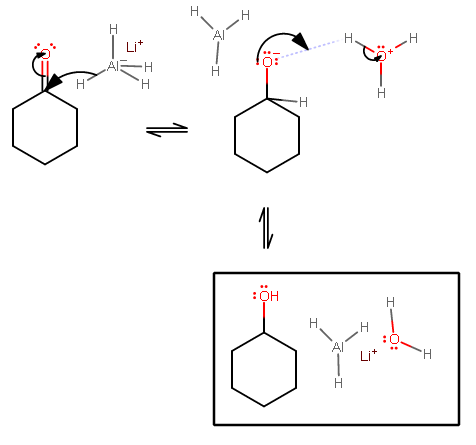How can we get 1-methylcyclohexanol from cyclohexanone , by reduction using the reagent LiALH4 in H2O/H+ , I got cyclohexanol , then what should I do?
1 Answer
Also, it is typically NOT used on ketones or aldehydes, because those are reactive enough to be reduced by
LITHIUM ALUMINUM HYDRIDE ON CYCLOHEXANONE
Noting that the lithium cation does not participate and simply acts as a counterion, we can focus on the (tetrahedral)
Due to the empty

The hydride is donated straight off of the aluminum hydride, giving an oxyanion intermediate. Then, the intermediate can form an alcohol once you add a bit of acid for a reaction workup/"finishing-up".
You still technically have
And that's why you got cyclohexanol.
CYCLOHEXANONE TO 1-METHYLCYCLOHEXANOL
To instead get 1-methylcyclohexanol, one option you should have been taught is a Grignard reagent.
What you could use here is methyl magnesium bromide.
(You can make it by simply reacting methyl bromide with magnesium solid in dissolved in anhydrous diethyl ether.)
This mechanism then follows:
The Grignard reagent acts like an anionic nucleophile; in this case, a methyl anion, which is quite good---it's because the pKa of methane is about
The diethyl ether has to be anhydrous so that the Grignard reagent doesn't accidentally grab a proton from water and deactivate itself.
The acid workup then finishes up the reaction.
SIDE PRODUCTS
The resultant water can then easily donate a proton to the methyl anion, and the Grignard reagent becomes methane, while the magnesium bromide becomes a side product.
Technically, any remaining acid would ultimately give you some
From this, actually, you can see how the deactivation occurs; methane is a terrible nucleophile.

